
(a)
Interpretation:
The product of the reaction of
Concept introduction:
Answer to Problem 11.46AP
The product of the reaction of

Explanation of Solution
The compound

Figure 1
The product of the reaction of
(b)
Interpretation:
The product of the reaction of
Concept introduction:
Epoxides undergo nucleophilic ring opening reactions which are base-catalyzed. If the epoxide is unsymmetrical, then the anionic nucleophile will attack the less-hindered carbon atom of the ring. If the reaction conditions are basic, then the reaction will occur at the less substituted carbon atom.
Answer to Problem 11.46AP
The product of the reaction of

Explanation of Solution
The compound

Figure 2
The product of the reaction of
(c)
Interpretation:
The product of the reaction of
Concept introduction:
Epoxides undergo nucleophilic ring-opening reactions which are base-catalyzed. If the epoxide is unsymmetrical, then the anionic nucleophile will attack the less-hindered carbon atom of the ring. If the reaction conditions are basic, then the reaction will occur at the less substituted carbon atom.
Answer to Problem 11.46AP
The product of the reaction of
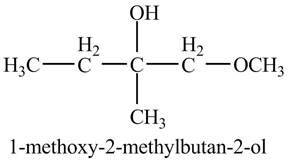
Explanation of Solution
The compound

Figure 3
The product of the reaction of
(d)
Interpretation:
The product of the reaction of
Concept introduction:
Epoxides undergo nucleophilic ring-opening reactions which are acid-catalyzed. If the epoxide is unsymmetrical, then the anionic nucleophile will attack the less-hindered carbon atom of the ring. If the reaction conditions are acidic, then the reaction will occur at the more substituted carbon atom.
Answer to Problem 11.46AP
The product of the reaction of
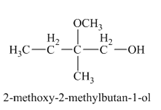
Explanation of Solution
The compound

Figure 4
The product of the reaction of
(e)
Interpretation:
The product of the reaction of
Concept introduction:
Epoxides undergo nucleophilic ring opening reactions which are acid-catalyzed. If the epoxide is unsymmetrical, then the anionic nucleophile will attack the less-hindered carbon atom of the ring. If the reaction conditions are acidic, then the reaction will occur at the more substituted carbon atom.
Answer to Problem 11.46AP
The product of the reaction of
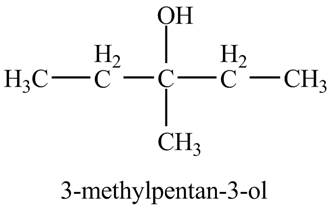
Explanation of Solution
The compound

Figure 5
The product of the reaction of
(f)
Interpretation:
The product of the reaction of the product of part (c) with
Concept introduction:
Epoxides undergo nucleophilic ring-opening reactions which are acid-catalyzed. If the epoxide is unsymmetrical, then the anionic nucleophile will attack the less-hindered carbon atom of the ring. If the reaction conditions are acidic, then the reaction will occur at the more substituted carbon atom.
Answer to Problem 11.46AP
The product of the reaction of the product of part (c) with

Explanation of Solution
In the presence of
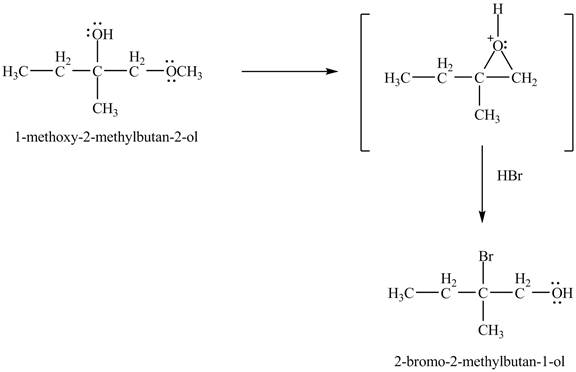
Figure 6
The product of the reaction of the given compound with
(g)
Interpretation:
The product of the reaction of the product of part (d) with
Concept introduction:
Epoxides undergo nucleophilic ring-opening reactions which are acid-catalyzed. If the epoxide is unsymmetrical, then the anionic nucleophile will attack the less-hindered carbon atom of the ring. If the reaction conditions are acidic, then the reaction will occur at the more substituted carbon atom.
Answer to Problem 11.46AP
The product of the reaction of the product of part (d) with
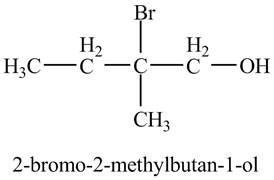
Explanation of Solution
In the presence of

Figure 7
The product of the reaction of the given compound with
(h)
Interpretation:
The product of the reaction of the product of part (c) with
Concept introduction:
The metal hydride reagents are good reducing agents such as
Answer to Problem 11.46AP
The product of the reaction of the product of part (c) with

Explanation of Solution
The base

Figure 8
The product of the reaction of the given compound with
(i)
Interpretation:
The product of the reaction of the product of part (d) with
Concept introduction:
The metal hydride reagents are good reducing agents such as
Answer to Problem 11.46AP
The product of the reaction of the product of part (d) with
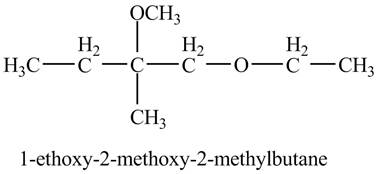
Explanation of Solution
The base

Figure 9
The product of the reaction of the given compound with
(j)
Interpretation:
The product of the reaction of the product of part (a) with periodic acid is to be predicted.
Concept introduction:
The periodic acid acts as a strong oxidizing agent. The periodic acid reacts with a vicinal diol to form two
Answer to Problem 11.46AP
The products of the reaction of the product of part (a) with periodic acid are shown below.

Explanation of Solution
The given compound is vicinal diol. It reacts with periodic acid to form two aldehydes. The carbon-carbon bond between the carbon atoms attached to two adjacent hydroxyl groups gets breaks. The corresponding chemical reaction is shown below.

Figure 10
The products of the reaction of the given compound with periodic acid are shown in Figure 10.
(k)
Interpretation:
The product of the reaction of the product of part (f) with
Concept introduction:
Grignard reagents are
Answer to Problem 11.46AP
The product of the reaction of the product of part (f) with
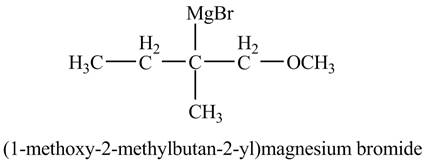
Explanation of Solution
The compound

Figure 11
The product of the reaction of the given compound with
(l)
Interpretation:
The product of the reaction of the product of part (k) with ethylene oxide followed by addition of
Concept introduction:
Grignard reagents are organometallic compounds which are prepared using alkyl halides in the presence of magnesium metal in dry ether. These reagents act as strong nucleophiles and bases. Grignard reagents react with carbonyl compounds to form alcohol.
Answer to Problem 11.46AP
The product of the reaction of the product of part (k) with ethylene oxide followed by addition of
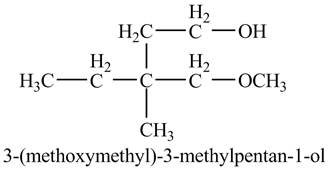
Explanation of Solution
Grignard reagent can act as a nucleophile. In the presence of an acid, it can attack the more substituted carbon atom of the epoxy ring. The Grignard reagent reacts with the ethylene oxide followed by protonolysis to form alcohol. The corresponding chemical reaction is shown below.

Figure 12
The product of the reaction of the given compound with ethylene oxide followed by addition of
Want to see more full solutions like this?
Chapter 11 Solutions
ORGANIC CHEMISTRY (LL)+ SAPLING ACC >BI
- Isoprene has sometimes been used as a starting material in the laboratory synthesis of terpenes. In one such synthesis, the first step is the electrophilic addition of 2 mol of hydrogen bromide to isoprene to give 1,3-dibromo-3-methylbutane.Write a series of equations describing the mechanism of this reaction.arrow_forwardCompound A, C 10H 18O, undergoes reaction with dilute H 2SO 4 at 50 °C to yield a mixture of two alkenes, C 10H 16. The major alkene B, gives only cyclopentanone after ozone treatment followed by reduction with zinc in acetic acid. Which of the following reactions are correct. Can be more than one answerarrow_forwardAn unknown hydrocarbon A with the formula C6H12 reacts with 1 molar equivalent of H2 over a palladium catalyst to give hydrocarbon B. Hydrocarbon A also reacts with OsO4 to give the glycol C. When oxidized with KMnO4 in acidic solution, A gives two fragments. One fragment is propanoic acid, CH3CH2COOH, and the other fragment is ketone D (R2C=O). What are the structures of A, B, C and D? Write all reactions.arrow_forward
- The formation of Br2 from NBS first involves the reaction of NBS with HBr to form an iminol intermediate and molecular bromine. The intermediate then undergoes acid-catalyzed tautomerism to form succinimide, the byproduct of the reaction. Propose a curved-arrow mechanism for the conversion of NBS into succinimide that also accounts for the formation of Br2.arrow_forwardA synthetic organic molecule, G, which contains both aldehyde and ether functional groups, is subjected to a series of reactions in a multi-step synthesis pathway. In the first step, G undergoes a Wittig reaction, leading to the formation of an alkene, H. Subsequently, H is treated with an ozone (O3) reagent followed by a reducing agent in an ozonolysis reaction, resulting in the formation of two different products, I and J. Considering the functional groups present in G and the nature of the reactions involved, what are the most probable structures or functional groups present in products I and J? A. I contains a carboxylic acid group, and J contains an aldehyde group. B. I contains a ketone group, and J contains an alcohol group. C. I and J both contain aldehyde groups. D. I contains an ester group, and J contains a ketone group. Don't use chat gpt.arrow_forwardReaction of aqueous sodium hydroxide on chlorobenzene gives which of the following products?arrow_forward
- An organic compound A of unknown structure was found to have a molecular formula C8H16. When A was poured in water and heated, compound B having a molecular formula C8H18O was formed. B upon heating with sulfuric acid was converted to C as the major product which is identical to A. Ozonolysis of C gave one molecule each of two different products D and E, both having a molecular formula C4H8O. Write the reactions involved and determine the structure of A,B,C,D and E.arrow_forwardSeveral sulfonylureas, a class of compounds containing RSO2NHCONHR, are useful drugs as orally active replacements for injected insulin in patients with adult-onset diabetes. These drugs decrease blood glucose concentrations by stimulating b cells of the pancreas to release insulin and by increasing the sensitivity of insulin receptors in peripheral tissues to insulin stimulation. Tolbutamide is synthesized by the reaction of the sodium salt of p-toluenesulfonamide and ethyl N-butylcarbamate . Propose a mechanism for this step.arrow_forwardA compound X of molecular formula C7H14 when hydrogenated produces 2,4-dimethylpentane and when hydroborated the obtained alcohol is 2,4-dimethyl-1-pentanol. a. What is the structure of X? b. If X is reacted with H2O catalyzed by H2SO4, what product is obtained? Write the structure, give the name, and write the complete mechanism, step by step of this reaction, in such a way as to explain the formation of the compound (DO NOT FORGET THE CORRECT USE OF ARROWS!).arrow_forward
- 4. Compound A has the formula C 8H 8. It reacts rapidly with KMnO 4 to give CO 2 and a carboxylic acid, B (C 7H 6O 2), but reacts with only 1 molar equivalent of H 2 on catalytic hydrogenation over a palladium catalyst. On hydrogenation under conditions that reduce aromatic rings, 4, equivalents of H 2 are taken up and hydrocarbon C (C 8H 16) is produced. What are the structures of A, B, and C.arrow_forwardCompound A (C11H23Br) is a secondary alkyl halide. On being heated with a solution of sodium ethoxide in ethanol, compound A yielded a mixture of two alkenes B and C, each having molecular formula C11H22. Catalytic hydrogenation of the major isomer B or the minor isomer C gave only 3,5-diethylheptane. Draw structures for compounds A, B, and C consistent with these observations.arrow_forwardA graduate student was studying enzymatic reductions of cyclohexanones when she encountered some interesting chemistry. When she used an enzyme and NADPH to reduce the following ketone, she was surprised to find that the product was optically active. She carefully repurified the product so that no enzyme, NADPH, or other contaminants were present. Still, the product was optically active. If this reaction could be accomplished using H2 and a nickel catalyst, would the product be optically active? Explain.arrow_forward
 Organic ChemistryChemistryISBN:9781305580350Author:William H. Brown, Brent L. Iverson, Eric Anslyn, Christopher S. FootePublisher:Cengage Learning
Organic ChemistryChemistryISBN:9781305580350Author:William H. Brown, Brent L. Iverson, Eric Anslyn, Christopher S. FootePublisher:Cengage Learning
 General, Organic, and Biological ChemistryChemistryISBN:9781285853918Author:H. Stephen StokerPublisher:Cengage Learning
General, Organic, and Biological ChemistryChemistryISBN:9781285853918Author:H. Stephen StokerPublisher:Cengage Learning


